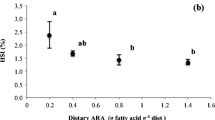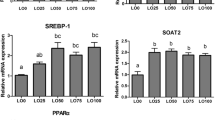Abstract
Conjugated linoleic acids (CLA) are the focus of numerous studies, yet the effects of these isomers of octadecadienoic acids have not been evaluated in many species of fish. In this study, graded amounts of CLA-0,0.5, 0.75, or 1.0% of the diet—were fed to juvenile hybrid striped bass for 8 wk. Dietary treatments were fed to apparent satiation twice daily to triplicate groups of fish initially weighing 13.4 g/fish. Feed intake and weight gain of fish fed 1.0% CLA were significantly reduced compared to fish fed no CLA. Fish fed 0.5 and 0.75% CLA exhibited reduced feed intake similar to fish fed 1.0% CLA, but had growth rates that were not significantly different from those of fish fed no CLA. Feed efficiency improved significantly in fish as dietary CLA concentrations increased. Total liver lipid concentrations were significantly reduced in fish fed the diets containing CLA compared to those of fish fed the control diet, and intraperitoneal fat ratio was significantly lower in fish fed 1.0% CLA compared to fish fed no CLA. Fish fed dietary CLA exhibited significant increases in hepatosomatic index and moisture content of muscle and carcass. The CLA isomers were detected in liver and muscle of fish fed the diets containing CLA, while a low concentration of one isomer was detected in liver and muscle of fish fed the control diet. Dietary CLA resulted in a significant increase in 18∶2(c-9,c-12) concentration in liver and muscle, but a significant reduction in 18∶1n−7 in these tissues. Furthermore, feeding CLA resulted in a significant increase in the concentration of 20∶5n−3 and 22∶6n−3 in liver, but a reduction of these fatty acids in muscle. This study showed that feeding CLA elevated tissue concentrations of these fatty acid isomers, reduced tissue lipid contents, improved feed efficiency, and altered fatty acid concentrations in liver and muscle of fish.
Similar content being viewed by others
Abbreviations
- CLA:
-
conjugated linoleic acids
- E/P:
-
energy/protein
- FAME:
-
fatty acid methyl ester
- HSI:
-
hepatosomatic index
- IPF:
-
intraperitoneal fat
References
Haumann, B.F. (1996) Conjugated Linoleic Acid Offers Research Promise,INFORM 7, 152–159.
Parodi, P.W. (1996) Milk Fat Components: Possible Chemopreventive Agents for Cancer and Other Diseases,Aust. J. Dairy Technol. 51, 24–32.
Sugano, M., Tsujita, A., Yamasaki, M., Yamada, K., Ikeda, I., and Kritchevsky, D. (1997) Lymphatic Recovery, Tissue Distribution, and Metabolic Effects of Conjugated Linoleic Acid in Rats,J. Nutr. Biochem. 8, 38–43.
Decker, E.A. (1995) The Role of Phenolics, Conjugated Linoleic Acid, Carnosine, and Pyrroloquinoline Quinone as Nonessential Dietary Antioxidants,Nutr. Rev. 53, 49–58.
Hayek, M.G., Han, S.N., Wu, D., Watkins, B.A., Meydani, M., Dorsey, J.L., Smith, D.E., and Meydani, S.N. (1999) Dietary Conjugated Linoleic Acid Influences the Immune Response of Young and Old C57BL/6NCrlBR Mice,J. Nutr. 129, 32–38.
Lee, K.N., Kritchevsky, D., and Pariza, M.W. (1994) Conjugated Linoleic Acid and Atherosclerosis in Rabbits,Atherosclerosis 108, 19–25.
Scimeca, J.A., Thompson, H.J., and Ip, C. (1994) Effects of Conjugated Linoleic Acid on Carcinogenesis, inDiet and Breast Cancer (Weisburger, E.K., ed.), Plenum Press, New York, pp. 59–65.
Ip, C. (1994) Conjugated Linoleic Acid in Cancer Prevention Research: a Report of Current Status and Issues, Special Report Prepared for the National Livestock and Meat Board, Research Report No. 100-104, Washington, DC.
Chin, S.F., Storkson, J.M., Albright, K.J., Cook, M.E., and Pariza, M.W. (1994) Conjugated Linoleic Acid Is a Growth Factor for Rats as Shown by Enhanced Weight Gain and Improved Feed Efficiency,J. Nutr. 124, 2344–2349.
Cook, M.E., Miller, C.C., Park, Y., and Pariza, M. (1993) Immune Modulation by Altered Nutrient Metabolism: Nutritional Control of Immune-Induced Growth Depression,Poult. Sci. 72, 1301–1305.
Li, Y., and Watkins, B.A. (1998) Conjugated Linoleic Acids Alter Bone Fatty Acid Composition and Reduceex vivo Prostaglandin E2 Biosynthesis in Rats Fed n−6 or n−3 Fatty Acids,Lipids 33, 417–425.
Park, Y., Albright, K.J., Liu, W., Storkson, J.M., Cook, M.E., and Pariza, M.W. (1997) Effect of Conjugated Linoleic Acid on Body Composition in Mice,Lipids 32, 853–858.
Choi, B.-D., Kang, S.-J., Ha, Y.-L., and Ackman, R.G. (1999) Accumulation of Conjugated Linoleic Acid (CLA) in Tissues of Fish Fed Diets Containing Various Levels of CLA, inQuality Attributes of Muscle Foods (Xiong, Y.L., Ho, C.-T., and Shahidi, F., eds.), pp. 61–71, Kluwer Academic/Plenum Publishers, New York.
Belury, M.A., and Kempa-Steczko, A. (1997) Conjugated Linoleic Acid Modulates Hepatic Lipid Composition in Mice,Lipids 32, 199–204.
Kramer, J.K.G., Sehat, N., Dugan, M.E.R., Mossoba, M.M., Yurawecz, M.P., Roach, J.A.G., Eulitz, K., Aalhus, J.L., Schaefer, A.L., and Ku, Y. (1998) Distributions of Conjugated Linoleic Acid (CLA) Isomers in Tissue Lipid Classes of Pigs Fed a Commercial CLA Mixture Determined by Gas Chromatography and Silver Ion-High-Performance Liquid Chromatography,Lipids 33, 549–558.
Sebedio, J.L., Juaneda, P., Dobson, G., Ramilison, I., Martin, J.C., Chardigny, J.M., and Christie, W.W. (1997) Metabolites of Conjugated Isomers of Linoleic Acid (CLA) in the Rat,Biochim. Biophys. Acta 1345, 5–10.
New, M.B. (1997) Aquaculture and the Capture Fisheries—Balancing the Scales,World Aquacult. 28, 11–30.
Mortensen, A., Hansen, B.F., Hansen, J.F., Frandsen, H., Bartnikowska, E., Andersen, P.S., and Bertelsen, L.S. (1998) Comparison of the Effects of Fish Oil and Olive Oil on Blood Lipids and Aortic Atherosclerosis in Watanabe Heritable Hyperlipidaemic Rabbits,Br. J. Nutr. 80, 565–573.
Uauy-Dagach, R., and Valenzuela, A. (1996) Marine Oils: the Health Benefits of n−3 Fatty Acids,Nutr. Rev. 54, S102-S108.
Brown, P.B., Griffin, M.E., and White, M.R. (1993) Experimental and Practical Diet Evaluations with Juvenile Hybrid Striped Bass,J. World Aquacult. Soc. 24, 80–89.
Griffin, M.E., Wilson, K.A., and Brown, P.B. (1994) Dietary Arginine Requirement of Juvenile Hybrid Striped Bass,J. Nutr. 124, 888–893.
Griffin, M.E., Brown, P.B., and Grant, A. (1992) Dietary Lysine Requirement of Juvenile Hybrid Striped Bass,J. Nutr. 122, 1332–1337.
Griffin, M.E., White, M.R., and Brown, P.B. (1994) Total Sulfur Amino Acid Requirement and Cysteine Replacement Value for Juvenile Hybrid Striped Bass (Morone saxatilis × M. chrysops),Comp. Biochem. Phys. 108A, 423–429.
NRC (National Research Council) (1993)Nutrient Requirements of Fish National Academy Press, Washington, DC.
Griffin, M.E., Wilson, K.A., White, M.R., and Brown, P.B. (1994) Dietary Choline Requirement of Juvenile Hybrid Striped Bass,J. Nutr. 124, 1685–1689.
Nematipour, G.R., Brown, M.L., and Gatlin, D.M. (1992) Effects of Dietary Energy:Protein Ratio on Growth Characteristics and Body Composition of Hybrid Striped Bass,Morone chrysops×M. saxatilis, Aquaculture 107, 359–368.
Wilson, R.P., Harding, D.E., and Garling, D.L. (1977) Effect of Dietary pH on Amino Acid Utilization and the Lysine Requirement of Fingerling Channel Catfish,J. Nutr. 107, 166–170.
Folch, J., Lees, M., and Sloan Stanley, G.H. (1957) A Simple Method for the Isolation and Purification of Total Lipides from Animal Tissues,J. Biol. Chem. 226, 497–509.
Ip, C., Chin, S.F., Scimeca, J.A., and Pariza, M.A. (1991) Mammary Cancer Prevention by Conjugated Derivatives of Linoleic Acid,Cancer Res. 51, 6118–6124.
West, D.B., Delany, J.P., Camet, P.M., Blohm, F., Truett, A.A., and Scimeca, J. (1998) Effects of Conjugated Linoleic Acid on Body Fat and Energy Metabolism in the Mouse,Am. J. Physiol. 275, R667-R672.
Sisk, M., Azain, M.J., and Hausman, D.B. (1998) Effect of Conjugated Linoleic Acid on Fat Pad Weights and Cellularity in Sprague-Dawley and Zucker Rats,FASEB J. 12, A536 (abs.).
Moya-Camarena, S.Y., Vanden Heuvel, J.P., and Belury, M.A. (1999) Conjugated Linoleic Acid Activates Peroxisome Proliferator-Activated Receptor α and β Subtypes but Does Not Induce Hepatic Peroxisome Proliferation in Sprague-Dawley Rats,Biochim. Biophys. Acta 1436, 331–342.
Nematipour, G.R., and Gatlin, D.M. (1993) Requirement of Hybrid Striped Bass for Dietary (n-3) Highly Unsaturated Fatty Acids,J. Nutr. 123, 744–753.
Author information
Authors and Affiliations
Corresponding author
About this article
Cite this article
Twibell, R.G., Watkins, B.A., Rogers, L. et al. Effects of dietary conjugated linoleic acids on hepatic and muscle lipids in hybrid striped bass. Lipids 35, 155–161 (2000). https://doi.org/10.1007/BF02664765
Received:
Revised:
Accepted:
Issue Date:
DOI: https://doi.org/10.1007/BF02664765




